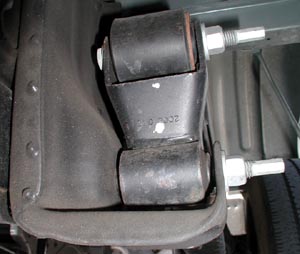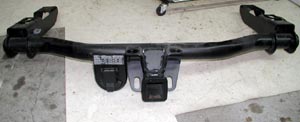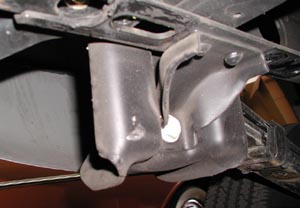
Installing Velvet- Ride Shackles
On a Chevrolet 2500HD

| Heavy duty trucks are designed to handle
loads with ease. However, the suspension on these vehicles gives a harsh
ride when the vehicle is unloaded. Lord Corporation has come up with a
solution. By changing the rear spring shackle to a two-piece unit that
pivots in the middle, the unloaded ride can be improved. The
key to the Velvet-Ride shackle is the torsion busing. This rubber
bushing in the center of the Velvet-Ride shackle allows the shackle to
stretch and compress several inches.
Tired of the constant bucking, hopping, and skipping we experienced using this truck on a daily basis, we decided to try a set of these on our 2002 Chevrolet 2500HD Crew Cab 4x4. The installation took about two hours on this particular vehicle, mostly due to the steps needed to remove the stock shackle bolts. Follow along as we install the Velvet-Ride shackles. At the end, you'll find our driving impressions. |
| As you can see, the stock shackles are installed with the bolts heads facing the frame. While this may have worked fine during assembly of the truck, it makes removing the shackles a chore. |  |
| Before you remove the last two bolt, place a jack stand under one side of the hitch. This will allow for one-man removal and installation of the hitch. |  |
 |
With the hitch set aside, you can now begin to remove the shackle bolts. First, remove the nuts from the shackle bolts. |
| Now that you have seen how to install the
Velvet-Ride shackles, the most important question still remains, do they
work?
We took the truck out for a test drive on familiar roads, including the dips, driveways, and railroad tracks we encounter on a daily basis. We were extremely impressed with the results. The shackles take the edge off many the hard jolts we previously experienced. Instead of slowing down as we often do, we charged full-speed at the most annoying obstacles. The truck just ate them up. Most sharp jolts are now 50% to 75% reduced, and instead of jumping, the truck seems to glide over most disturbances. The rough ride on certain roads is not completely eliminated, but overall the ride is improved. The ride is now half as bouncy and much less jerky. Stiffer shocks would complement this suspension modification nicely, and should help reduce the bouncing on uneven roads. We were most impressed with the improvement while cornering on uneven surfaces. Previously the truck tended to hop and skip when cornering quickly. Not only is this annoying, but it can also be dangerous. These shackles really seem to help in this aspect. If that alone were the only benefit, we would say these shackles would be worth their price. It is still apparent that this is a heavy duty truck. The front torsion bars still overcompensate when the vehicle is unloaded, which is to be expected. This is a vehicle capable of towing well over twice its weight. Because the shackles change in length as load is applied, they do affect the ride-height of the vehicle. Upon initial installation, the rear dropped by 1/2-inch. When measured a day later, the rear had settled to almost 1-inch below stock height. This change is barely noticeable when looking at the truck, and when it is not loaded, the rear is still a couple inches higher than the front. When loaded, the rear will be a couple inches lower over stock. If the rear-end squat is too much, an air-over-leaf airbag assist system can be used level the truck when it is heavily loaded. ChevyHD.com |